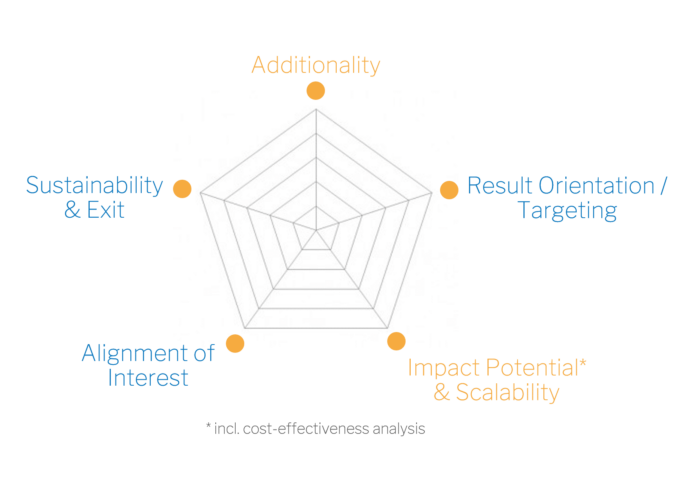Investment Strategy
We invest within the scope of pre-defined Impact-Linked Funds related to specific themes, programs and geographies. Each of these funds has, in addition to the aspects described below, specific selection and investment criteria that will be published via open calls. We hope for your understanding that we cannot accept applications outside these calls.
Stay tuned for our upcoming calls.
We understand and use the term “investment” in a wider sense that includes, besides debt and equity, instruments such as payments for results and grants made conditional on the attainment of specific outcomes.
What our investees need to fulfil
We provide financing to organizations and enterprises committed to achieving measurable impact with a scalable business model. Targeted organizations need to fulfil the following 6 criteria:
How we select the appropriate Impact-Linked Finance instrument
We provide innovative finance in multiple forms by using a variety of non-repayable and repayable financial instruments that link financial terms to realized outcomes.
If not pre-determined by a specific program, the criteria for assessing and selecting the appropriate financing instrument and its terms are:
(1) Additionality:
To which extent does the proposed financing instrument and its terms mobilize additional private resources and make a difference beyond ‘what would happen anyway’ (or better/faster)?
(2) Results Orientation & Targeting:
How precisely are the financing instrument and its terms targeted towards those activities that are most closely linked to the intended development outcomes?
(3) Impact Potential & Scalability (incl. cost-effectiveness analysis):
How do the financing instrument and its terms support exploring the full potential for development impact and scalability? What are the expected benefits as compared to cost?
(4) Alignment of Interest:
How much aligned are the interests of all parties that are involved in the financing model? Is there any risk of moral hazard or market distortion?
(5) Sustainability & Exit:
How do the financing instrument and its terms encourage the exit of concessional finance and the financial self-sustainability of the intervention?
There is another important criterion for deciding on the appropriate type of funding:
(1) either using the funding primarily to mobilize additional investment (e.g. SIINC-type instruments for blended finance) or
(2) providing the capital from a single source (e.g. using Impact-Linked Debt or Equity instruments as direct impact investment).








